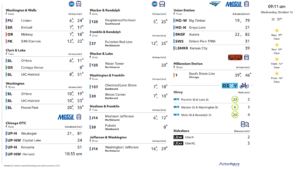This blog post is a summary of the article “Why a hybrid office needs to understand and support employee commutes with transport information,” (PDF) by Matt Caywood, PhD and Aaron Rinaca in Corporate Real Estate Journal Volume 11 Number 2, published by Henry Stewart Publications.
Free lunches! Unlimited snacks! Outdoor activities! Big work areas! Stocked fridges!
Back-to-office strategies include a lot of things to lure people back, and some are good. Amenities may nudge towards short-term employee happiness in this transition, but many employers are overlooking a number one reason people don’t want to return in the first place: the commute.

84% have said “not commuting” is the top benefit of working from home. The cost savings of not having to go to the office ranked second. In this survey, these two reasons even ranked ahead of avoiding COVID-19 exposure, as well as the prospect of being away from family and pets. Not having a commute being the top benefit of working from home is backed up by numerous other employee surveys and research (e.g. 1, 2, 3, 4, 5, 6).
People are willing to quit over the prospect of commuting again. In 2020, four times more employees cited commuting as a reason for quitting compared to 2010. With millions upon millions of Americans quitting their jobs, employers are working to better understand what their relationship will be with their employees’ commutes in order to retain and recruit.
It’s easy to understand why commutes are overlooked: the traditional view was that the commute itself is an employee responsibility, not an employer responsibility. Employers dictated that employees had to be in the office at a certain time five days a week, and employees had to comply, using whatever transportation they could. That paradigm was starting to break down before the pandemic, and it’s now ancient history. In reality, most people – including you – view commuting as part of your workday because work is the reason you are making the trip. The time, costs, and stresses involved with commuting flow from the workplace.
Some employers already have some form of engagement regarding commutes with their employees in the form of tax-free benefits, but it is rare for an employer to have someone on staff truly focused on employee commutes unless the regulatory environment warrants it. In San Francisco, Seattle, and Washington, D.C., for example, employer engagement on commutes might exist solely for compliance with commuter benefits laws. It’s frequently lumped in with other HR responsibilities like facilitating health care plans and employee-sponsored retirement programs. But similarly to how most employees are not experts on navigating their health care choices and 401(k) options, many are also not well-versed on all of the commute choices available to them and what the actual costs and benefits of those choices are.
Employees are Seeing the Costs of Driving
Car commuting, by far the most common way to commute, is a lot more expensive than many realize. An average parking spot in downtown Washington, D.C., for example, is around $3,000 yearly, or nearly $15 each work day, a cost paid by the employer or the employee. On top of this, all of the other costs of car commuting are stacked on the employee, such as vehicle payments, depreciation, insurance, fuel, and maintenance. In 2020, AAA estimated the average yearly cost of car ownership is close to $10,000, and Nerdwallet in 2021 pegged the number closer to $12,000 yearly. LendingTree in 2021 estimated the costs of car commuting alone – not including the use of the car outside of commuting – can be as high as $15,000 in some cities. Today in 2022, oil prices and the cost of vehicles continue to rise, and accordingly, so will the costs of car commutes.
With so many working remotely in the last couple years, the savings of not driving to work every day is significantly more tangible than it ever has been before. As a result, some new in-office amenities may not outweigh the disadvantages of commuting, especially by car.
Hybrid is Here to Stay
Hybrid work environments, where employees work some days in the workspace and some work remote, is here to stay. Per Morning Consult, two thirds of current remote workers are now comfortable going back to the office, but over 80% say they enjoy working remotely and three out of four say they are more productive working remotely. A La Salle Network survey found that 77% of organizations plan to adopt a hybrid work model. A McKinsey survey of 100 executives found nine out of ten organizations will be combining remote and on-site working. Nicholas Bloom, a professor of economics at Stanford University who has studied work from home for almost two decades, estimates about half of the workforce will be full time at their place of work, 35% will have some type of hybrid approach with a mix of in-office time and remote work, and only 15% will remain fully remote. Whatever metric or study you look at, it’s clear hybrid work is a major part of the future.
Employers switching to hybrid work schedules opposed to reverting to a full in-office environment are not just making a positive impact on employee satisfaction, they are also making a huge improvement on their carbon footprint, especially if the majority of employees would have normally commuted by car daily.
Commutes Do Not Need to Be What They Were
Easing the pain of commuting is something the employer must now engage in to retain and recruit employees. Thankfully, when employees are engaged, commutes do change. Many may not actually know what their transit commute looks and feels like even if they live near a bus stop, it’s unlikely an employee knows their options for vanpooling, and perhaps an employee hasn’t tried using a subway or train for commuting even though they may live a mile away from a stop. A Harvard Business School study showed one out of ten changed their commutes after receiving personalized commute plans.

Some enjoy a good commute! In addition to the value for those who want more of a barrier between work and home life, those who use high-quality transportation have a healthy and positive experience. Commutes are best if they can walk or bike, especially with the proliferation of electric bicycles and cities’ work to create networks of protected bike lanes. In a creative survey, given the opportunity to instantly teleport to the office, effectively removing the commute, one in three of people who bike or walk would prefer to keep the bike or walk commute! Bottom line, when employees switch to a better commute, they have higher overall satisfaction going into the office.
Now is the time to treat employees as a partner in the journey back to the office. As you transition back to the workplace fully or to a hybrid schedule, providing employees with insights on their travel choices is more essential than ever, and it might make the difference between an employee coming back or quitting.
Matt Caywood, PhD, is CEO and Co-founder of Actionfigure, and co-author of “Why a hybrid office needs to understand and support employee commutes with transport information,” (PDF) in Corporate Real Estate Journal Volume 11 Number 2, published by Henry Stewart Publications. Corporate Real Estate Journal is a London-based peer-reviewed professional journal for corporate real estate and workplace executives. The full article expands on this blog post, including office employee archetypes as they relate to commutes.



